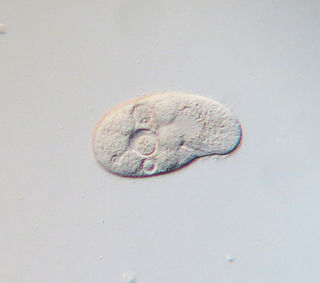
Tetrahymena, a unicellular eukaryote, is a genus of free-living ciliates. The genus Tetrahymena is the most widely studied member of its phylum. It can produce, store and react with different types of hormones. Tetrahymena cells can recognize both related and hostile cells.

Sphingosine kinase (SphK) is a conserved lipid kinase that catalyzes formation sphingosine-1-phosphate (S1P) from the precursor sphingolipid sphingosine. Sphingolipid metabolites, such as ceramide, sphingosine and sphingosine-1-phosphate, are lipid second messengers involved in diverse cellular processes. There are two forms of SphK, SphK1 and SphK2. SphK1 is found in the cytosol of eukaryotic cells, and migrates to the plasma membrane upon activation. SphK2 is localized to the nucleus.

Chemotaxis receptors are expressed in the surface membrane with diverse dynamics, some of them have long-term characteristics as they are determined genetically, others have short-term moiety as their assembly is induced ad hoc in the presence of the ligand. The diverse feature of the chemotaxis receptors and ligands provides the possibility to select chemotactic responder cells with a simple chemotaxis assay. By chemotactic selection we can determine whether a still not characterized molecule acts via the long- or the short-term receptor pathway. Recent results proved that chemokines are working on long-term chemotaxis receptors, while vasoactive peptides act more on the short-term ones. Term chemotactic selection is also used to design a technique which separates eukaryotic or prokaryotic cells upon their chemotactic responsiveness to selector ligands.

Chemotaxis assays are experimental tools for evaluation of chemotactic ability of prokaryotic or eukaryotic cells. A wide variety of techniques have been developed. Some techniques are qualitative - allowing an investigator to approximately determine a cell's chemotactic affinity for an analyte - while others are quantitative, allowing a precise measurement of this affinity.

Geosiphon is a genus of fungus in the family Geosiphonaceae. The genus is monotypic, containing the single species Geosiphon pyriformis, first described by Kützing in 1849 as Botrydium pyriforme. In 1915, Von Wettstein characterized Geosiphon pyriforme as a multinucleate alga containing endosymbiotic cyanobacteria, although he also noted the presence of chitin, a component of fungal cell walls. In 1933, Knapp was the first to suggest the fungal origin of the species and described it as a lichen with endosymbiotic cyanobacteria. It is the only member of the Glomeromycota known to not form a symbiosis with terrestrial plants in the form of arbuscular mycorrhiza.

Nepenthes × pyriformis is a natural hybrid involving N. inermis and N. talangensis. It is known only from Mount Talang in Sumatra, to which N. talangensis is endemic. Nepenthes talangensis was only described as a distinct species in 1994. Prior to this it was placed within N. bongso and some of the older literature identifies this hybrid as N. bongso × N. inermis.

Eucalyptus pyriformis, commonly known as pear-fruited mallee or Dowerin rose, is a species of low, straggly mallee that is endemic to Western Australia. It has smooth greyish brown bark sometimes with ribbony bark near the base, egg-shaped to lance-shaped adult leaves, flower buds in groups of three, red, pinkish or creamy white flowers and down-turned, conical fruit with prominent ribs.
The enzyme pseudouridylate synthase (EC 4.2.1.70) catalyzes the chemical reaction
The enzyme dolichyl-phosphatase (EC 3.1.3.51) catalyzes the reaction
In enzymology, a citrullinase (EC 3.5.1.20) is an enzyme that catalyzes the chemical reaction
In enzymology, a cytidylate kinase is an enzyme that catalyzes the chemical reaction

Macbecin belongs to the ansamycin family of antibiotics and was first isolated from actinomycete bacteria. Macbecin possesses potent antitumor properties. In-vitro studies have shown that Macbecin is effective in the eradication of Gram-positive bacteria, fungi, and protozoa including Tetrahymena pyriformis.
Trimastix is a genus of excavates, the sole occupant of the order Trimastigida. Trimastix are bacterivorous, free living and anaerobic. When first observed in 1881 by William Kent, the morphology of Trimastix was not well described but over time the oral structure and flagellar organization have become clearer. There are few known species, and the genus's role in the ecosystem is largely unknown. However, it is known that they generally live in marine environments within the tissues of decaying organisms to maintain an anoxic environment. Much interest in this group is related to its close association with other members of Anaeromonadea. These organisms do not have classical mitochondria, and as such, much of the research involving these microbes is aimed at investigating the evolution of mitochondria.
Tetrahymanol synthase (EC 4.2.1.123, squalene tetrahymanol cyclase) is an enzyme with systematic name squalene hydro-lyase (tetrahymanol forming). This enzyme catalyses the following chemical reaction

Myrmecia pyriformis, also known as the bull ant or inch ant, is an Australian ant. Myrmecia pyriformis belongs to the genus Myrmecia. It is abundant in many major cities of Australia, but mostly spotted in the eastern states. The species is of a similar appearance to the Myrmecia forficata.

Colpidium colpoda are free-living ciliates commonly found in many freshwater environments including streams, rivers, lakes and ponds across the world. Colpidium colpoda is also frequently found inhabiting wastewater treatment plants. This species is used as an indicator of water quality and waste treatment plant performance.

Ian Read Gibbons, was a biophysicist and cell biologist. He discovered and named dynein, and demonstrated energy source as ATP is sufficient for dynein to walk on microtubules. In 2017, he and Ronald Vale received the Shaw Prize for their research on microtubule motor proteins.
Arnold Gerhard Fredrickson was an American chemical engineer and professor in the department of chemical engineering and materials science (CEMS) at the University of Minnesota. He was known for his work in transport phenomena, bioengineering and population dynamics. Fredrickson was the author of over 100 scientific publications and advisor to over 50 graduate students. He was recognized for his contributions to chemical engineering with election as fellow to the American Association for the Advancement of Science (1997) and fellow and founding member of the American Institute of Medical and Biological Engineers (1993).

Protopulvinaria pyriformis, commonly known as the pyriform scale, is a species of soft scale insect in the family Coccidae. It is a pest of avocado and is found in many countries around the world where avocados grow.

Tetrahymena thermophila is a species of Ciliophora in the family Tetrahymenidae. It is a free living protozoa and occurs in fresh water.












